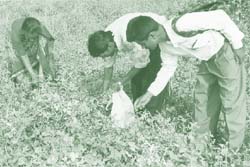Colours of Nature
 punjab durrie weavers ( pdw ), a non-governmental organisation, operating from Chandigarh and Mumbai, is collecting information on dyes available from plants and microbes. pdw intends to utilise traditional knowledge to encourage cultivation of such plants on marginal lands. Chemical dyes pollute. Alternative dyeing pigments, extractable from plants and microbes, can help reduce the pollution. Dyeing pigments can be extracted from at least 600 plant species. And Indian communities have a vast reservoir of knowledge of these.
punjab durrie weavers ( pdw ), a non-governmental organisation, operating from Chandigarh and Mumbai, is collecting information on dyes available from plants and microbes. pdw intends to utilise traditional knowledge to encourage cultivation of such plants on marginal lands. Chemical dyes pollute. Alternative dyeing pigments, extractable from plants and microbes, can help reduce the pollution. Dyeing pigments can be extracted from at least 600 plant species. And Indian communities have a vast reservoir of knowledge of these.
About 200-300 plant species, that may be used for extracting dyeing pigment, are available in the Western Ghats. pdw' s pilot project is, therefore, operational in nine villages of Maharashtra and two of Goa. The method of working is simple. While a textile historian searches for information from texts and books, field collectors go about collecting samples of the plants and microbes with the help of the villagers.
Some of the plant species, for which samples have been collected, such as Indian madder ( Rubia cordifolia), are fast disappearing. Only one sample of Indian madder could be found over a 1,000 hectare area. By collecting samples of rare plant species, the project is helping preserve the biodiversity as well. "We have been able to collect more than 200 samples,' informs Bosco Henriques, deputy national project coordinator of pdw. The field collectors also inform the residents of villages, being covered under the project, regarding the economic potential of the plants.
Once the sample is picked, the relevant part is identified, dried, powdered and sent to dyeing centres where the dyeing pigments are extracted. Cotton fabric is used to test the fastness of the dye. "Cotton is the most difficult fabric to dye,' says Henriques. Till date, about 150 species of dye yielding plants have been powdered and about 90 have been successfully used as dyes. "A good 80 per cent of these plants have the potential to be used for dyes in the handloom and furnishings sector,' says Henriques.
As a part of the project, indigenous methods of dyeing are also being studied. pdw members have been visiting the traditional weavers to learn their techniques and reproduce them under controlled laboratory conditions.
Pigment from microbes Other natural sources of dyeing pigments are microbes. The project is researching on these as well. "There are many microbes that produce pigments,' informs Henriques. These dyeing pigments in the microbes, available in concentrate form, can be extracted and used instead of the chemical dyes. Certain microbes have been isolated and research is on to develop a process to grow them in bulk and extract pigments. The emphasis is to identify microbes and develop techniques that allow small and rural entrepreneurs to undertake microbe culturing, using low-cost methods. "We have been able to identify 18 microbes so far and have extracted pigments using simple processes out of five of them,' says Henriques.
As soon as the pilot project is completed, recommendations will be submitted by pdw to the Union ministry of environment and forests. Recommended plant species will be made available to the farmers. The advantage of such a participatory approach is not limited to economic profits. The physical spread of the rural dyeing industry can help spread the waste biomass over large areas, making waste management easier. "Traditional dyers are keen to use our processes. Our dyes need less water and have better fastening properties. Also, they come in more colours than the usual chemical dyes,' says Henriques.
Farmers of Maharashtra, covered by the project, are cultivating these crops without the use of chemical fertilisers. They are being helped by pdw to maintain records and take post-harvest care of the produce.
Related Content
- Food Safety and Standards (Food Products Standards and Food Additives) First Amendment Regulations, 2023
- State of marine protected area management effectiveness in South Africa
- Report on management of bio-medical waste, Uttar Pradesh, 24/07/2020
- Clay idols that speak for environment
- Order of the Supreme Court of India regarding a comprehensive action plan for air pollution control, 13/08/2018
- Africa: Do Soldiers Care About the Environment? a Study in South Africa Suggests They Do
